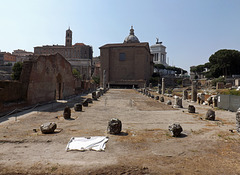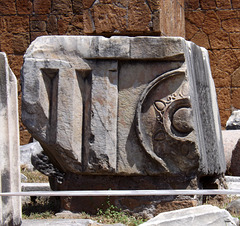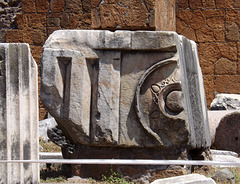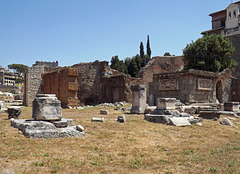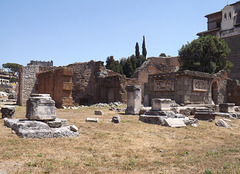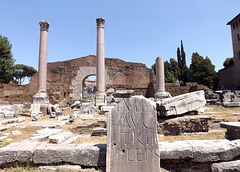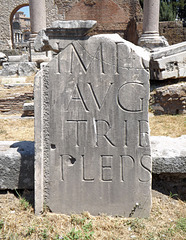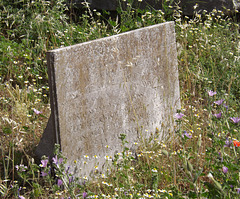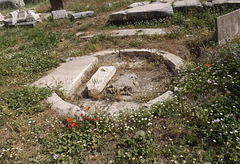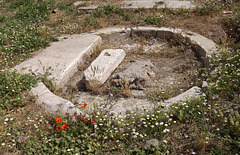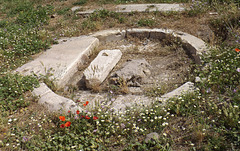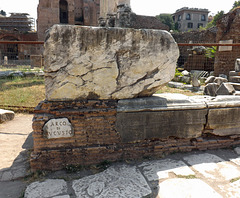
Forum Romanum & Palatine Hill
Folder: Italy
The Basilica Aemilia in the Forum in Rome, July 20…
| |
|
The Basilica Aemilia (Italian: Basilica Emilia) was a civil basilica in the Roman forum, in Rome, Italy. Today only the plan and some rebuilt elements can be seen. The Basilica was 100 meters (328 ft) long and about 30 meters (98 ft) wide. Along the sides were two orders of 16 arches, and it was accessed through one of three entrances.
Pre-existing building: The new basilica was built on a site of the 5th century BC tabernae lanienae ("butcher shops") and later (4th century BC) the tabernae argentariae. The latter housed the city's bankers, and after a fire were renamed tabernae novae ("new shops"). The square had two facing rows of shops. A first basilica had been built behind the tabernae argentariae between 210 BC and 195-191 BC, date in which it is mentioned by Plautus. Archaeological studies have shown that this building comprised three naves paved with tuff from Monteverde, the back façade having a portico which opened to the Forum Piscatorium and the Macellum (the area later occupied by the Forum of Nerva).
The Basilica Fulvia-Aemilia: It was erected in 179 BC by censor Marcus Fulvius Nobilior with the name of Basilica Fulvia. After the latter's death, his colleague Marcus Aemilius Lepidus completed it, and it was frequently restored and redecorated by the members of the Aemilian gens, giving the basilica its current name.
The 78 BC consul, homonymous of the preceding one, embellished it with the clipei ("shields"). This intervention is recalled in a coin from 61 BC by his son, Marcus Aemilius Lepidus (see images).
According to other scholars, however, the Basilica Aemilia formed a different edifice from the Basilica Fulvia.
The Basilica Paulli: A new edifice in substitution of the Basilica Fulvia was begun in 55 BC by Lucius Aemilius Lepidus Paullus, and inaugurated by his son in 34 BC. This edifice had similar lines to the preceding one; however with a reduced length and a second nave in lieu of the back portico.
The columns in the central nave, in African marble, had Corinthian capitals and friezes with deeds from the history of Republican Rome. The columns in the second row were in cipolline marble and, finally, the external ones had Ionic capitals.
After a fire, Augustus in 14 BC heavily restored the edifice. In this occasion the tabernae which preceded it towards the Forum square and the portico were totally rebuilt. The latter was dedicated to the emperor's two grandsons (Porticus Gai et Luci): it had two orders of arcades with pilasters and Doric semi-columns. The two upper floors of the basilica were totally rebuilt. Over the upper order an attic was built, decorated with vegetable elements and statues of barbarians.
The basilica was restored again in 22 AD. On its two-hundredth anniversary, the Basilica Aemilia was considered by Pliny to be one of the most beautiful buildings in Rome. It was a place for business and, in the porticus of Gaius and Lucius (the grandsons of Augustus) fronting the Roman Forum, there were the Tabernae Novae (New Shops).
On the colored marble floor one still can see the green stains of bronze coins that melted when Rome was sacked by Alaric the Visigoth in 410 AD.
Conspicuous remains of the basilica could still be seen in the Renaissance: they were however used for the Giraud-Torlonia Palace (also no longer existing).
Inside, there are several tabernae. The main hall or court is behind the shops. it was 328 feet in length and a depth of 98 feet
Text from: en.wikipedia.org/wiki/Basilica_Aemilia
Fragment with a Boucranium from the Basilica Aemil…
| |
|
Erected in 179 BC by the censors Marcus Aemilius Lepidus (after whom the basilica is named) and Marcus Fulvius Nobilior, completely rebuilt over two decades and dedicated in 34 BC, restored after a fire by Augustus in 14 BC, and then again in AD 22 on its two-hundredth anniversary, the Basilica Aemilia was considered by Pliny to be one of the most beautiful buildings in Rome. It was a place for business and, in the porticus of Gaius and Lucius (the grandsons of Augustus) fronting the Forum, there were the Tabernae Novae (New Shops). On the colored marble floor one still can see the stains of bronze coins.
Text from: penelope.uchicago.edu/~grout/encyclopaedia_romana/romanfo...
Fragment with a Boucranium from the Basilica Aemil…
| |
|
Erected in 179 BC by the censors Marcus Aemilius Lepidus (after whom the basilica is named) and Marcus Fulvius Nobilior, completely rebuilt over two decades and dedicated in 34 BC, restored after a fire by Augustus in 14 BC, and then again in AD 22 on its two-hundredth anniversary, the Basilica Aemilia was considered by Pliny to be one of the most beautiful buildings in Rome. It was a place for business and, in the porticus of Gaius and Lucius (the grandsons of Augustus) fronting the Forum, there were the Tabernae Novae (New Shops). On the colored marble floor one still can see the stains of bronze coins.
Text from: penelope.uchicago.edu/~grout/encyclopaedia_romana/romanfo...
Fragment from the Basilica Aemilia in the Forum Ro…
| |
|
Erected in 179 BC by the censors Marcus Aemilius Lepidus (after whom the basilica is named) and Marcus Fulvius Nobilior, completely rebuilt over two decades and dedicated in 34 BC, restored after a fire by Augustus in 14 BC, and then again in AD 22 on its two-hundredth anniversary, the Basilica Aemilia was considered by Pliny to be one of the most beautiful buildings in Rome. It was a place for business and, in the porticus of Gaius and Lucius (the grandsons of Augustus) fronting the Forum, there were the Tabernae Novae (New Shops). On the colored marble floor one still can see the stains of bronze coins.
Text from: penelope.uchicago.edu/~grout/encyclopaedia_romana/romanfo...
Fragment from the Basilica Aemilia in the Forum Ro…
| |
|
Erected in 179 BC by the censors Marcus Aemilius Lepidus (after whom the basilica is named) and Marcus Fulvius Nobilior, completely rebuilt over two decades and dedicated in 34 BC, restored after a fire by Augustus in 14 BC, and then again in AD 22 on its two-hundredth anniversary, the Basilica Aemilia was considered by Pliny to be one of the most beautiful buildings in Rome. It was a place for business and, in the porticus of Gaius and Lucius (the grandsons of Augustus) fronting the Forum, there were the Tabernae Novae (New Shops). On the colored marble floor one still can see the stains of bronze coins.
Text from: penelope.uchicago.edu/~grout/encyclopaedia_romana/romanfo...
Remains of the Basilica Aemilia in the Forum Roman…
| |
|
Erected in 179 BC by the censors Marcus Aemilius Lepidus (after whom the basilica is named) and Marcus Fulvius Nobilior, completely rebuilt over two decades and dedicated in 34 BC, restored after a fire by Augustus in 14 BC, and then again in AD 22 on its two-hundredth anniversary, the Basilica Aemilia was considered by Pliny to be one of the most beautiful buildings in Rome. It was a place for business and, in the porticus of Gaius and Lucius (the grandsons of Augustus) fronting the Forum, there were the Tabernae Novae (New Shops). On the colored marble floor one still can see the stains of bronze coins.
Text from: penelope.uchicago.edu/~grout/encyclopaedia_romana/romanfo...
Remains of the Basilica Aemilia in the Forum Roman…
| |
|
Erected in 179 BC by the censors Marcus Aemilius Lepidus (after whom the basilica is named) and Marcus Fulvius Nobilior, completely rebuilt over two decades and dedicated in 34 BC, restored after a fire by Augustus in 14 BC, and then again in AD 22 on its two-hundredth anniversary, the Basilica Aemilia was considered by Pliny to be one of the most beautiful buildings in Rome. It was a place for business and, in the porticus of Gaius and Lucius (the grandsons of Augustus) fronting the Forum, there were the Tabernae Novae (New Shops). On the colored marble floor one still can see the stains of bronze coins.
Text from: penelope.uchicago.edu/~grout/encyclopaedia_romana/romanfo...
Remains of the Basilica Aemilia in the Forum Roman…
| |
|
Erected in 179 BC by the censors Marcus Aemilius Lepidus (after whom the basilica is named) and Marcus Fulvius Nobilior, completely rebuilt over two decades and dedicated in 34 BC, restored after a fire by Augustus in 14 BC, and then again in AD 22 on its two-hundredth anniversary, the Basilica Aemilia was considered by Pliny to be one of the most beautiful buildings in Rome. It was a place for business and, in the porticus of Gaius and Lucius (the grandsons of Augustus) fronting the Forum, there were the Tabernae Novae (New Shops). On the colored marble floor one still can see the stains of bronze coins.
Text from: penelope.uchicago.edu/~grout/encyclopaedia_romana/romanfo...
Remains of the Basilica Aemilia in the Forum Roman…
| |
|
Erected in 179 BC by the censors Marcus Aemilius Lepidus (after whom the basilica is named) and Marcus Fulvius Nobilior, completely rebuilt over two decades and dedicated in 34 BC, restored after a fire by Augustus in 14 BC, and then again in AD 22 on its two-hundredth anniversary, the Basilica Aemilia was considered by Pliny to be one of the most beautiful buildings in Rome. It was a place for business and, in the porticus of Gaius and Lucius (the grandsons of Augustus) fronting the Forum, there were the Tabernae Novae (New Shops). On the colored marble floor one still can see the stains of bronze coins.
Text from: penelope.uchicago.edu/~grout/encyclopaedia_romana/romanfo...
Remains of the Basilica Aemilia in the Forum Roman…
| |
|
Erected in 179 BC by the censors Marcus Aemilius Lepidus (after whom the basilica is named) and Marcus Fulvius Nobilior, completely rebuilt over two decades and dedicated in 34 BC, restored after a fire by Augustus in 14 BC, and then again in AD 22 on its two-hundredth anniversary, the Basilica Aemilia was considered by Pliny to be one of the most beautiful buildings in Rome. It was a place for business and, in the porticus of Gaius and Lucius (the grandsons of Augustus) fronting the Forum, there were the Tabernae Novae (New Shops). On the colored marble floor one still can see the stains of bronze coins.
Text from: penelope.uchicago.edu/~grout/encyclopaedia_romana/romanfo...
Inscription Near the Basilica Aemilia in the Forum…
| |
|
The Shrine of Venus Cloacina in the Forum, June 20…
| |
|
The Shrine of Venus Cloacina (Sacella Cloacinae or Sacrum Cloacina) — the "Shrine of Venus of the Sewer" — was a small sanctuary on the Roman Forum, honoring the divinity of the Cloaca Maxima, the spirit of the "Great Drain" or Sewer of Rome. Cloacina, the Etruscan goddess associated with the entrance to the sewer system, was later identified with the Roman goddess Venus for unknown reasons.
The Etruscan deity Cloacina may well have been associated originally with the small brook that later became the city's Cloaca Maxima, but the Shrine of Venus Cloacina is first mentioned by the playwright Plautus in the early 2nd century BC. It was located in the Forum in front of the Tabernae Novae ("new shops") and on the Via Sacra. The Tabernae Novae were replaced by the expanded Basilica Aemilia in the middle Republic (179 BC), but the Shrine was preserved. The round masonry Shrine probably dates from this construction (or major remodeling).
Legend, however, ascribes the origin of the Shrine to the period of the Sabine king Titus Tatius (8th century BC), during the reign of Romulus. It was also according to legend that the father of the virtuous Verginia, a butcher in one of the stalls of the Tabernae Novae, came out and stabbed his daughter rather than let her fall victim to the lecherous attentions of Appius Claudius in 449 BC. (This was said to have occurred on the future site of the Shrine.)
Coins minted during the Second Triumvirate (ca. 42 BC) by a moneyer named Lucius Mussidius Longus give a fairly clear visual representation of the shrine. They show a round sacellum (small, uncovered shrine) with a metal balustrade. The scant archaeological remains uncovered between 1899 and 1901 (round travertine substructure, marble rim, diameter 2.40 meters) conform nicely to the pictures on the coins. In his Natural History (77-79 AD), Pliny the Elder refers to signa Cloacinae, which were evidently the two statues shown on the coins and perhaps some other, unidentified objects. One of the statues is holding or waving an object (possibly a flower). Each statue has a low pillar with a bird on it (flowers and birds were well known attributes of Venus). It is not known why there are two statues.
The Romans believed that a good sewage system was important for the future success of Rome, as a good sewer system was necessary for the physical health of Roman citizens. Additionally, Romans worshipped Cloacina as the goddess of purity and the goddess of filth. Cloacina’s name is probably derived the Latin verb cloare (“to purify” or “to clean”), or from cloaca (“sewer)”.
Text from: en.wikipedia.org/wiki/Shrine_of_Venus_Cloacina
The Shrine of Venus Cloacina in the Forum, June 20…
| |
|
The Shrine of Venus Cloacina (Sacella Cloacinae or Sacrum Cloacina) — the "Shrine of Venus of the Sewer" — was a small sanctuary on the Roman Forum, honoring the divinity of the Cloaca Maxima, the spirit of the "Great Drain" or Sewer of Rome. Cloacina, the Etruscan goddess associated with the entrance to the sewer system, was later identified with the Roman goddess Venus for unknown reasons.
The Etruscan deity Cloacina may well have been associated originally with the small brook that later became the city's Cloaca Maxima, but the Shrine of Venus Cloacina is first mentioned by the playwright Plautus in the early 2nd century BC. It was located in the Forum in front of the Tabernae Novae ("new shops") and on the Via Sacra. The Tabernae Novae were replaced by the expanded Basilica Aemilia in the middle Republic (179 BC), but the Shrine was preserved. The round masonry Shrine probably dates from this construction (or major remodeling).
Legend, however, ascribes the origin of the Shrine to the period of the Sabine king Titus Tatius (8th century BC), during the reign of Romulus. It was also according to legend that the father of the virtuous Verginia, a butcher in one of the stalls of the Tabernae Novae, came out and stabbed his daughter rather than let her fall victim to the lecherous attentions of Appius Claudius in 449 BC. (This was said to have occurred on the future site of the Shrine.)
Coins minted during the Second Triumvirate (ca. 42 BC) by a moneyer named Lucius Mussidius Longus give a fairly clear visual representation of the shrine. They show a round sacellum (small, uncovered shrine) with a metal balustrade. The scant archaeological remains uncovered between 1899 and 1901 (round travertine substructure, marble rim, diameter 2.40 meters) conform nicely to the pictures on the coins. In his Natural History (77-79 AD), Pliny the Elder refers to signa Cloacinae, which were evidently the two statues shown on the coins and perhaps some other, unidentified objects. One of the statues is holding or waving an object (possibly a flower). Each statue has a low pillar with a bird on it (flowers and birds were well known attributes of Venus). It is not known why there are two statues.
The Romans believed that a good sewage system was important for the future success of Rome, as a good sewer system was necessary for the physical health of Roman citizens. Additionally, Romans worshipped Cloacina as the goddess of purity and the goddess of filth. Cloacina’s name is probably derived the Latin verb cloare (“to purify” or “to clean”), or from cloaca (“sewer)”.
Text from: en.wikipedia.org/wiki/Shrine_of_Venus_Cloacina
The Shrine of Venus Cloacina in the Forum, June 20…
| |
|
The Shrine of Venus Cloacina (Sacella Cloacinae or Sacrum Cloacina) — the "Shrine of Venus of the Sewer" — was a small sanctuary on the Roman Forum, honoring the divinity of the Cloaca Maxima, the spirit of the "Great Drain" or Sewer of Rome. Cloacina, the Etruscan goddess associated with the entrance to the sewer system, was later identified with the Roman goddess Venus for unknown reasons.
The Etruscan deity Cloacina may well have been associated originally with the small brook that later became the city's Cloaca Maxima, but the Shrine of Venus Cloacina is first mentioned by the playwright Plautus in the early 2nd century BC. It was located in the Forum in front of the Tabernae Novae ("new shops") and on the Via Sacra. The Tabernae Novae were replaced by the expanded Basilica Aemilia in the middle Republic (179 BC), but the Shrine was preserved. The round masonry Shrine probably dates from this construction (or major remodeling).
Legend, however, ascribes the origin of the Shrine to the period of the Sabine king Titus Tatius (8th century BC), during the reign of Romulus. It was also according to legend that the father of the virtuous Verginia, a butcher in one of the stalls of the Tabernae Novae, came out and stabbed his daughter rather than let her fall victim to the lecherous attentions of Appius Claudius in 449 BC. (This was said to have occurred on the future site of the Shrine.)
Coins minted during the Second Triumvirate (ca. 42 BC) by a moneyer named Lucius Mussidius Longus give a fairly clear visual representation of the shrine. They show a round sacellum (small, uncovered shrine) with a metal balustrade. The scant archaeological remains uncovered between 1899 and 1901 (round travertine substructure, marble rim, diameter 2.40 meters) conform nicely to the pictures on the coins. In his Natural History (77-79 AD), Pliny the Elder refers to signa Cloacinae, which were evidently the two statues shown on the coins and perhaps some other, unidentified objects. One of the statues is holding or waving an object (possibly a flower). Each statue has a low pillar with a bird on it (flowers and birds were well known attributes of Venus). It is not known why there are two statues.
The Romans believed that a good sewage system was important for the future success of Rome, as a good sewer system was necessary for the physical health of Roman citizens. Additionally, Romans worshipped Cloacina as the goddess of purity and the goddess of filth. Cloacina’s name is probably derived the Latin verb cloare (“to purify” or “to clean”), or from cloaca (“sewer)”.
Text from: en.wikipedia.org/wiki/Shrine_of_Venus_Cloacina
The Shrine of Venus Cloacina in the Forum, June 20…
| |
|
The Shrine of Venus Cloacina (Sacella Cloacinae or Sacrum Cloacina) — the "Shrine of Venus of the Sewer" — was a small sanctuary on the Roman Forum, honoring the divinity of the Cloaca Maxima, the spirit of the "Great Drain" or Sewer of Rome. Cloacina, the Etruscan goddess associated with the entrance to the sewer system, was later identified with the Roman goddess Venus for unknown reasons.
The Etruscan deity Cloacina may well have been associated originally with the small brook that later became the city's Cloaca Maxima, but the Shrine of Venus Cloacina is first mentioned by the playwright Plautus in the early 2nd century BC. It was located in the Forum in front of the Tabernae Novae ("new shops") and on the Via Sacra. The Tabernae Novae were replaced by the expanded Basilica Aemilia in the middle Republic (179 BC), but the Shrine was preserved. The round masonry Shrine probably dates from this construction (or major remodeling).
Legend, however, ascribes the origin of the Shrine to the period of the Sabine king Titus Tatius (8th century BC), during the reign of Romulus. It was also according to legend that the father of the virtuous Verginia, a butcher in one of the stalls of the Tabernae Novae, came out and stabbed his daughter rather than let her fall victim to the lecherous attentions of Appius Claudius in 449 BC. (This was said to have occurred on the future site of the Shrine.)
Coins minted during the Second Triumvirate (ca. 42 BC) by a moneyer named Lucius Mussidius Longus give a fairly clear visual representation of the shrine. They show a round sacellum (small, uncovered shrine) with a metal balustrade. The scant archaeological remains uncovered between 1899 and 1901 (round travertine substructure, marble rim, diameter 2.40 meters) conform nicely to the pictures on the coins. In his Natural History (77-79 AD), Pliny the Elder refers to signa Cloacinae, which were evidently the two statues shown on the coins and perhaps some other, unidentified objects. One of the statues is holding or waving an object (possibly a flower). Each statue has a low pillar with a bird on it (flowers and birds were well known attributes of Venus). It is not known why there are two statues.
The Romans believed that a good sewage system was important for the future success of Rome, as a good sewer system was necessary for the physical health of Roman citizens. Additionally, Romans worshipped Cloacina as the goddess of purity and the goddess of filth. Cloacina’s name is probably derived the Latin verb cloare (“to purify” or “to clean”), or from cloaca (“sewer)”.
Text from: en.wikipedia.org/wiki/Shrine_of_Venus_Cloacina
Temple of Divine Iulius in the Forum in Rome, July…
| |
|
The Temple of Caesar or Temple of Divus Iulius (Latin Aedes Divi Iuli or Templum Divi Iuli, Italian Tempio del Divo Giulio) also known as Temple of the Deified Julius Caesar, delubrum, heroon or Temple of the Comet Star,[1] is an ancient structure in the Roman Forum of Rome, Italy, located near the Regia and the Temple of Vesta.
It was begun by Augustus in 42 BC after the senate deified Julius Caesar posthumously. Augustus dedicated the prostyle temple (it is still unknown if it was Ionic, Corinthian or Composite) to Caesar (his adoptive father) on August 18, 29 BC, after the Battle of Actium. It stands on the east side of the main square of the Roman Forum (Forum), between the Regia, Temple of Castor and Pollux and the Basilica Aemilia, on the site of Caesar's cremation (Caesar's testament was read at the funeral by Mark Antony).
Caesar was the first resident of Rome to be deified and so honored with a temple.[2] A fourth flamen maior was dedicated to him after 44 BC and Mark Antony was appointed as his flamen.
Commemorative plaque beside Caesar's altar.
The high platform on which the temple was built served as a rostra (Rostra ad divi Iuli) and, like the rostra at the opposite end of the Forum, was decorated with the beaks of ships taken at the battle of Actium.
The Temple of Caesar was the only temple to be entirely dedicated to the cult of a comet (referred to as a 'comet star'). The comet, upon its appearance some time after Caesar's murder (44 BC), was considered to be the soul of the deified Julius Caesar and the symbol of the "new birth" of Augustus as the unique Roman ruler and Emperor. Here the account by Pliny with parts of a public speech delivered by Augustus about the comet, his father Caesar and his own destiny:
The only place in the whole world where a comet is the object of worship is a temple at Rome. [...] His late Majesty Augustus had deemed this comet very propitious to himself; as it had appeared not [...] long after the decease of his father Caesar. [...] People believed that this star signified the soul of Caesar received among the spirits of the immortal gods.
In Greek and Roman culture, comet is an adjective determining the distinctive characteristic of a special star. So "comet star" means "long-haired star", and it was represented this way on coins and monuments.
The "Divine Star" was represented and worshiped on coins and probably in the temple itself, as a "comet star" or as a "simple star": the simple star has been used as a general symbol of Divinity since 44 BC [see 44 BC coins series]; after the appearance of the comet, the simple star was transformed into a comet by adding the tail to one of the rays of the simple star [see 37-34 BC, 19-18 BC and 17 BC coins series].
According to Appian the place near the Regia and probably part of the Main Square of the Roman Forum was a second choice, because the first intention of the Roman people was to bury Caesar on the Capitoline Hill among the other Gods of Rome. However, the Roman priests prevented them from doing so (in fact, the cremation was considered not safe due to the many wooden structures there) and the corpse of Caesar was carried back to the Forum near the Regia, being the Regia the personal headquarters of Caesar as Pontifex Maximus: this is the reason why, after a violent quarrel about the funeral pyre and the destiny of the ashes of Caesar, the Roman people, the men of Caesar's party and the men of Caesar's family decided to build the pyre in that place. It seems that in that very place at that time there was probably a tribunal which, after the funeral of Caesar and the building of the Temple, was then moved in front of the Temple of Caesar, probably in the location of the so called Rostra Diocletiani. The tribunal was a tribunal praetoris sub divo with gradus and was known as tribunal Aurelium, a structure built by C. Aurelius Cotta around 80 BC, near the so-called Puteal Libonis, a bidental used for the sacred oath before the trials.
The corpse of
Temple of Divine Iulius in the Forum in Rome, July…
| |
|
The Temple of Caesar or Temple of Divus Iulius (Latin Aedes Divi Iuli or Templum Divi Iuli, Italian Tempio del Divo Giulio) also known as Temple of the Deified Julius Caesar, delubrum, heroon or Temple of the Comet Star,[1] is an ancient structure in the Roman Forum of Rome, Italy, located near the Regia and the Temple of Vesta.
It was begun by Augustus in 42 BC after the senate deified Julius Caesar posthumously. Augustus dedicated the prostyle temple (it is still unknown if it was Ionic, Corinthian or Composite) to Caesar (his adoptive father) on August 18, 29 BC, after the Battle of Actium. It stands on the east side of the main square of the Roman Forum (Forum), between the Regia, Temple of Castor and Pollux and the Basilica Aemilia, on the site of Caesar's cremation (Caesar's testament was read at the funeral by Mark Antony).
Caesar was the first resident of Rome to be deified and so honored with a temple.[2] A fourth flamen maior was dedicated to him after 44 BC and Mark Antony was appointed as his flamen.
Commemorative plaque beside Caesar's altar.
The high platform on which the temple was built served as a rostra (Rostra ad divi Iuli) and, like the rostra at the opposite end of the Forum, was decorated with the beaks of ships taken at the battle of Actium.
The Temple of Caesar was the only temple to be entirely dedicated to the cult of a comet (referred to as a 'comet star'). The comet, upon its appearance some time after Caesar's murder (44 BC), was considered to be the soul of the deified Julius Caesar and the symbol of the "new birth" of Augustus as the unique Roman ruler and Emperor. Here the account by Pliny with parts of a public speech delivered by Augustus about the comet, his father Caesar and his own destiny:
The only place in the whole world where a comet is the object of worship is a temple at Rome. [...] His late Majesty Augustus had deemed this comet very propitious to himself; as it had appeared not [...] long after the decease of his father Caesar. [...] People believed that this star signified the soul of Caesar received among the spirits of the immortal gods.
In Greek and Roman culture, comet is an adjective determining the distinctive characteristic of a special star. So "comet star" means "long-haired star", and it was represented this way on coins and monuments.
The "Divine Star" was represented and worshiped on coins and probably in the temple itself, as a "comet star" or as a "simple star": the simple star has been used as a general symbol of Divinity since 44 BC [see 44 BC coins series]; after the appearance of the comet, the simple star was transformed into a comet by adding the tail to one of the rays of the simple star [see 37-34 BC, 19-18 BC and 17 BC coins series].
According to Appian the place near the Regia and probably part of the Main Square of the Roman Forum was a second choice, because the first intention of the Roman people was to bury Caesar on the Capitoline Hill among the other Gods of Rome. However, the Roman priests prevented them from doing so (in fact, the cremation was considered not safe due to the many wooden structures there) and the corpse of Caesar was carried back to the Forum near the Regia, being the Regia the personal headquarters of Caesar as Pontifex Maximus: this is the reason why, after a violent quarrel about the funeral pyre and the destiny of the ashes of Caesar, the Roman people, the men of Caesar's party and the men of Caesar's family decided to build the pyre in that place. It seems that in that very place at that time there was probably a tribunal which, after the funeral of Caesar and the building of the Temple, was then moved in front of the Temple of Caesar, probably in the location of the so called Rostra Diocletiani. The tribunal was a tribunal praetoris sub divo with gradus and was known as tribunal Aurelium, a structure built by C. Aurelius Cotta around 80 BC, near the so-called Puteal Libonis, a bidental used for the sacred oath before the trials.
The corpse of
Remains of the Arch of Augustus in the Forum Roman…
| |
|
The Arch of Augustus was the triumphal arch of Augustus, located in the Roman Forum. It spanned the road between the Temple of Castor and Pollux and the Temple of Caesar, near the Temple of Vesta. Dedicated in 29 BC, it commemorates the Battle of Actium (31 BC) against Mark Antony and Cleopatra.
An inscription was found in the same location in 1546 AD, with a dedication to Augustus, so the identification of the arch is certain even though very little remains of the arch itself. Its appearance is known from Augustan coins. It had three passageways, the first such arch in Rome, and served as a model for the Arch of Septimius Severus, which was the model for the Arch of Constantine.
Text from: en.wikipedia.org/wiki/Arch_of_Augustus,_Rome
Jump to top
RSS feed- Latest items - Subscribe to the latest items added to this album
- ipernity © 2007-2024
- Help & Contact
|
Club news
|
About ipernity
|
History |
ipernity Club & Prices |
Guide of good conduct
Donate | Group guidelines | Privacy policy | Terms of use | Statutes | In memoria -
Facebook
Twitter

